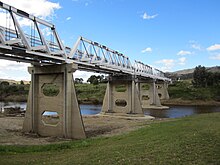Tharwa Bridge
| Tharwa Bridge | |
|---|---|

Tharwa Bridge is an Allan truss bridge over the Murrumbidgee River (looking North)
|
|
| Coordinates | Coordinates: 35°30′31″S 149°04′14″E / 35.508579°S 149.070539°E |
| Carries | Tharwa Drive |
| Crosses | Murrimbidgee River |
| Characteristics | |
| Design | Allan truss |
| Material | timber |
| Total length | 598 feet (182 m) |
| Width | 15 feet (4.6 m) |
| No. of spans | 4 |
| Piers in water | 2 |
| Load limit | 5 tonnes |
| No. of lanes | 1 |
| History | |
| Designer | Percy Allan |
| Constructed by | McClure Bros |
| Inaugurated | 27 March 1895 |
Tharwa Bridge is a four span Allan truss bridge that provides a high-level crossing point across the Murrumbidgee River, allowing traffic between Canberra and Tharwa village. It is the oldest surviving bridge in the Australian Capital Territory.
The bridge was opened on 27 March 1895, and a public holiday was declared in the region. A parade was held in Tharwa and 1500 people watched Mrs Elizabeth McKeahnie (the oldest resident of the area) open the bridge. The deck level of the bridge was based on the highest recorded flood level prior to building the bridge. A flood has not overtopped the bridge since construction. There is a mark on the concrete pier on the Western side of the river showing the flood level in 1991.
The bridge was entered in the ACT Heritage Register in 1998, is listed by the National Trust of Australia (ACT) and was entered on the Register of the National Estate by the Australian Heritage Commission in 1983.
The bridge has also been identified by Engineers Australia as a Major Engineering Heritage item and is one of the most significant pieces of heritage in the Australian Capital Territory.
The Tharwa Bridge and its site are historically and technically significant because of the Allan truss structure, having form and structural integrity which have survived virtually intact. It is the archetypal example of the application of the new technology by Percy Allan to the construction of timber road bridges in New South Wales during a major development phase for bridge and road construction during the last decade of the nineteenth century.
Tharwa Bridge is highly valued by the local community as an integral part of the village of Tharwa. It continues to contribute in social, economic and aesthetic terms to the community. The bridge and its site have associative significance with the period of nineteenth century European settlement and development of the region.
An engineering assessment of the bridge was undertaken in 1978 by structural engineering firm Hardcastle & Richards, which resulted in some upgrades. However, the bridge subsequently deteriorated.
The bridge was closed in April 2005 when a routine inspection identified extensive wood rotting (caused by termites) of a number of critical, structural elements of the bridge. During July and August 2005, Tharwa Bridge was strengthened with bailey panels to provide a temporary crossing for vehicles up to five tonne. This arrangement was to have been in place until 2008.
...
Wikipedia
